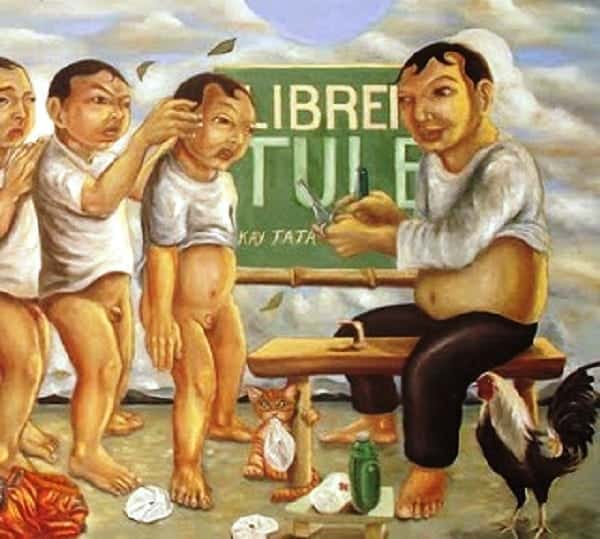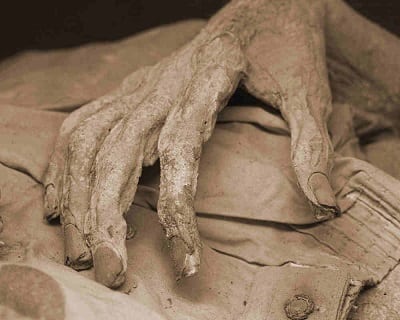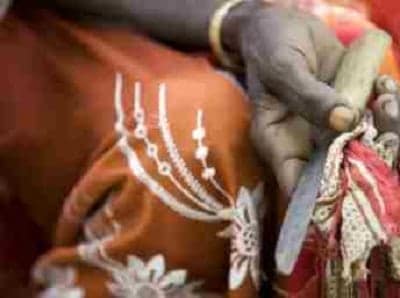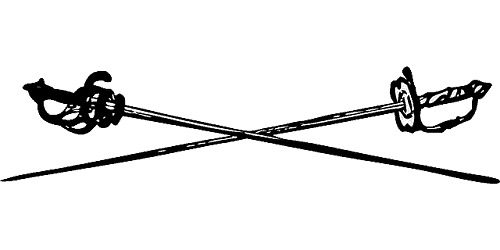10 Shocking Old-Timey Practices Filipinos Still Do Today

Contrary to popular belief, not all the shocking practices our ancestors used to do have been relegated to the dustbin of history. In fact, these practices—far from being consigned to the schoolbooks—are actually very much in vogue today (some more than others).
Also Read: 10 Reasons Why Life Was Better In Pre-Colonial Philippines
While the most famous of these would undoubtedly be the annual self-flagellation and self-crucifixion of penitents during Holy Week, let’s take a look at some of the other old-timey traditions Filipinos still practice today, especially those guaranteed to make someone’s mother faint.
1. Inserting “Bolitas” Into The Male Genitals

You might probably have heard how the Filipinos in pre-colonial times used to insert all sorts of implants and adornments into their genitals in order to enhance their partner’s sexual experience; apparently, the practice continues to be observed among members of the sea-faring community.
Related Trivia: Ancient Cebuanos used “genital jewelry”
That’s right, Filipino seamen are known to insert “bolitas” into their penises which they say make them a huge hit with foreign women. Gunnar Lamvik, the Norwegian researcher who made extensive research into this little-known practice, noted that aside from the carnal benefits, Filipino seamen also see it as a way of asserting their masculinity over their foreign competition as far as the labor market is concerned.
In a time when the number of seafarers from other countries is growing, the practice gives the Filipino seamen a huge boost in confidence and allows them to stand out from the rest.
2. “Binukot.”
Contrary to its depiction in Marian Rivera’s “Amaya” which scholars said had too many inaccuracies, the practice of “binukot” (Hiligaynon for “secluded”) was said to have been prevalent in pre-Spanish times, where the most beautiful girls of a community would be kept isolated by their families until they can be married off.
During their period of seclusion, the girls are treated like royalty and are forbidden from working and being exposed to the sunlight. They are also taught traditional dances and oral folklore, making them a rich source of the community’s history. Such a sheltered lifestyle would result in the girls becoming fair-skinned frail beauties who commanded prestige and a high price for their dowries when they became of age.
Also Read: 14 Amazing Filipina Heroines You Don’t Know But Should
The practice continued well until World War II when most of the “binukot”—unable to run to safety due to their frail conditions—fell victim to Japanese cruelty. Today, the number of “binukot” is dwindling and the practice is seemingly confined to the island of Panay.
3. “Pukpok.”
Known as traditional circumcision, “pukpok” is seen as a coming-of-age ritual for boys and is mostly done in many rural areas across the Philippines.
While many historians believe the practice of circumcision came from the Spaniards, others hold that it was the early Muslim settlers who introduced it. Unlike the modern method, traditional circumcision does not use anesthesia; instead, the boy is made to chew on guava leaves while the “manunuli” removes his foreskin with a sharpened wooden or steel implement. The chewed guava leaves are then placed on the wound to prevent infection.
Recommended Article: 9 Philippine Icons and Traditions That May Disappear Soon
As to why some Filipinos—especially those in the rural areas—continue to practice the traditional method, they believe it will contribute to the boy’s development of his secondary sexual characteristics as well as improve his virility when he becomes an adult.
4. “Kutkot.”
In a land filled with many quirky rituals for the dead, the Hanunuo Mangyans probably have the strangest of them all.
Located in the island of Mindoro, the tribe still observes the practice of “kutkot” where they literally dig up the remains of a loved one a year after his/her death and dress it up in clothes. To make the remains more human, the family bundles it up in clothes to form a mannequin-like figure called a “sinakot.”
Did you know? The Ibaloi also have a very unique way of honoring their dead
The “sinakot” would then be carried around by the family members back to the village where it is subjected to a tribal dance. Afterward, it would be kept by the family inside their home for a year before it is finally transferred to a cave containing other “sinakot.” Hanunuo Mangyans practice this ritual as a way to honor their dead.
5. Traditional Tattooing
We already know how pre-Spanish people—especially those in the Visayas—used to practice the art of indigenous tattooing so prevalently that they were called “pintados” by the Spanish due to having large amounts of tattoos on their bodies.
Unlike the modern method, traditional tattooing consists of pricking the skin with sharpened steel or wooden stick dipped in wet charcoal. The whole process—aside from being slower and more undoubtedly excruciating—could sometimes take months to finish especially when the tattoo design is large.
Also Read: The Many Faces of Whang-od, Philippines’ Legendary Tattooist
Sadly, practitioners—called “mambabatok”—have all but whittled down to Maria “Pangud” Oggay, a Kalinga woman who is considered to be the last of the traditional tattoo artists in the country. However, the Fil-American group Tatak ng Apat na Alon has worked to ensure traditional tattooing does not die out with Pangud by having their members practice and wear traditional tattoos themselves.
6. Horse-fighting

While technically illegal due to the Animal Welfare Act of 1998, horse-fighting continues to be observed in the Philippines especially during festivals in Mindanao.
Practiced by the “Lumads” (indigenous peoples) for half a millennium, the custom involves letting two stallions duke it out inside an enclosure, with the winner getting a mare in heat tied up in the ring’s center. As can be expected, the two horses would bite and kick each other until one gives up or is outright killed. In some cases, they would also end up injuring the mare amid the fighting.
Also Read: Top 10 Weirdest Philippine Animals
While the prevalence of the practice has drawn outrage from animal activists, those who continue to observe say it’s a part of their culture. Also, contrary to popular belief about the high injury and death rates among the combatants, organizers of these fights say the competitors often get out alive and are well-treated afterward since they are expensive and are needed as work animals in their communities.
7. Female Circumcision
Hard to believe, but it’s not only males whose genitals go under the knife in this country. Certain Muslim communities in the south also have their women undergo ritual circumcision called “Pag-Islam” or “Pag-Sunnat.”
As we can recall, female circumcision (or Female Genital Mutilation as the World Health Organization calls it) is a hugely controversial practice and has been condemned by many in the international community due to its harmful effects on women. Like its male counterpart, the tradition is said to have been introduced into the country by Muslim settlers, although another theory holds it was the pagan pre-Spanish Filipinos who started the ritual.
Did you know? The Bagobo also have a unique coming-of-age ritual for girls
Unfortunately, a comprehensive study into the practice has been limited; from what can be gathered from the data obtained by a researcher after studying it among the Yakan tribe in Basilan, the process does not involve cutting off any female genitals. Only the labia majora is scraped, making the procedure a bloodless one. Also, those who were interviewed—the practitioners, the patients, and their families—viewed the ritual in an extremely positive light.
8. Abortion
We already mentioned in a previous list how the women of pre-colonial times used to enjoy a lot of privileges; apparently, one of them included the right to abort any pregnancy if she already had the number of children she wanted.
To that end, the woman would usually employ the services of a “hilot” or an “albularyo” to induce abortion. With the subsequent coming of the Spanish, abortion was later criminalized and has remained so up until the present day and is only allowed among the most life-threatening circumstances.
READ: 15 Weird Laws Filipinos Still Have To Live With
Yet, the threat of incarceration has not stopped hundreds of thousands of women every year from seeking the services of the aforementioned in order to terminate their pregnancies which is accomplished through a variety of methods, including but not limited to manual massage and ingestion of herbal medicines.
9. Dueling
Arguably, the art of dueling has been around for as long as man knew how to hold a weapon. Of course, it was no different in the Philippines during the pre-colonial and Spanish era, especially with the abundance of sharp-edged weapons and exacerbated by the cultural emphasis on the vindication of one’s honor.
Also Read: 8 Epic Battles in History Where Filipinos Kicked Ass
Even the American attempt to eradicate the practice by making it a criminal offense through the Revised Penal Code did not entirely succeed, as news of Filipino knife-fighters regularly reached American newspapers. Nowadays, while duels to death are uncommon among urban folk, the practice can still be observed mainly among those living in faraway areas where laws cannot be effectively implemented and justice has to be meted out personally.
10. Whaling
A little-known fact: our ancestors, especially those living in the coastal areas, used to hunt whales, dolphins, whale sharks, and other large fish and mammals for subsistence. The practice, which was documented as early as the 17th century and became an industry during the different historical eras, was outlawed in 1997after it came under intense international scrutiny.
Unfortunately, no definitive conclusion can be reached as to whether the practice has really been eradicated. On the contrary, anti-whaling advocates concede that the ban may have merely forced the whalers to continue their operations in secret.
Also Read: 7 Prehistoric Animals You Didn’t Know Once Roamed The Philippines
Given the Philippines’ vast waters, the decreasing numbers of allowable species for catching plus the whalers’ livelihood needs, the practice may just be alive and well albeit in a hidden manner.
References
Acebes, J. (2009). Historical whaling in the Philippines: origins of ‘indigenous subsistence whaling’, mapping whaling grounds and comparison with current known distribution: a HMAP Asia Project Paper (1st ed.). Retrieved from http://goo.gl/ruhYdC
Arriola, F. (1993). The Body Book. Quezon City, Philippines: GCF Books.
Burgos, N. (2011). Culture scholars say ‘Amaya’ is inaccurate, misleading. Inquirer.net. Retrieved 3 February 2015, from http://goo.gl/zfQ26q
Cabrera, M. (2010). Filipino tribe brings back dead with “clothing” ritual. Reuters. Retrieved 3 February 2015, from http://goo.gl/7czY77
Christensen, J., & Tull, M. (2014). Historical Perspectives of Fisheries Exploitation in the Indo-Pacific. Springer Science & Business Media.
Garcia, B. (2012). Argument over rice harvest leads to bolo duel. Sun Star Zamboanga. Retrieved 3 February 2015, from http://goo.gl/Jc90XI
Jacobs, R. (2013). The Strange Sexual Quirk of Filipino Seafarers. The Atlantic. Retrieved 3 February 2015, from http://goo.gl/afSxUC
Karnow, S. (1989). In Our Image – America’s Empire in the Philippines. New York: Random House.
Lowe, A. (2014). Reviving the art of Filipino tribal tattoos. BBC News Asia. Retrieved 3 February 2015, from http://goo.gl/ctslqo
Maentz, J. (2012). On Mindanao’s Lumads and Horse Fighting. Jacob Images. Retrieved 3 February 2015, from http://goo.gl/tMehR8
Prescott Journal Miner,. (1920). Bolos Weapons In Filipino Duel; One Has Hand Cut Off, p. 4. Retrieved from http://goo.gl/2LQ87w
Torralba-Titgemeyer, L. (1997). La Mujer Indigena – The Native Woman: A description of the Filipino Woman during Pre-Spanish Time. Austrian-Philippine Website. Retrieved 3 February 2015, from http://goo.gl/7pThML
Ty, R. (2012). Circumcision via ‘pukpok’ still being practiced in PHL. GMA News Online. Retrieved 3 February 2015, from http://goo.gl/yXNX8T
VERA Files,. (2012). Mambabatok: Kalinga’s last traditional tattoo artist. Retrieved 3 February 2015, from
FilipiKnow
FilipiKnow strives to ensure each article published on this website is as accurate and reliable as possible. We invite you, our reader, to take part in our mission to provide free, high-quality information for every Juan. If you think this article needs improvement, or if you have suggestions on how we can better achieve our goals, let us know by sending a message to admin at filipiknow dot net
Copyright Notice
All materials contained on this site are protected by the Republic of the Philippines copyright law and may not be reproduced, distributed, transmitted, displayed, published, or broadcast without the prior written permission of filipiknow.net or in the case of third party materials, the owner of that content. You may not alter or remove any trademark, copyright, or other notice from copies of the content. Be warned that we have already reported and helped terminate several websites and YouTube channels for blatantly stealing our content. If you wish to use filipiknow.net content for commercial purposes, such as for content syndication, etc., please contact us at legal(at)filipiknow(dot)net


